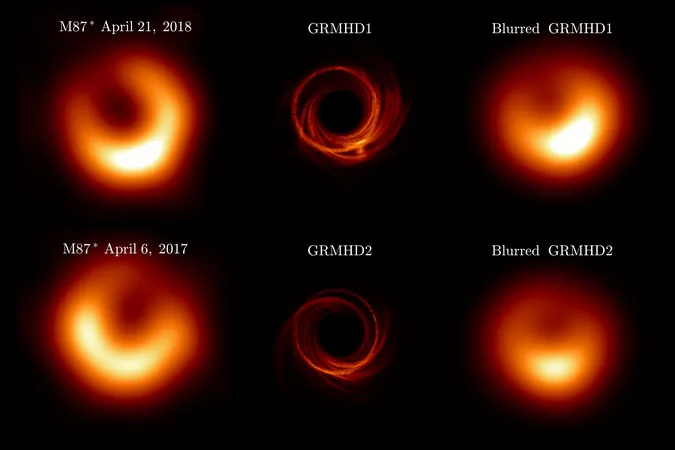
Groundbreaking Observations Reveal Turbulent Secrets of M87*: What’s Happening Inside This Supermassive Black Hole?
2025-01-22
Author: Michael
Recent Observations and Analysis
Recent observations conducted by the Event Horizon Telescope (EHT) Collaboration have taken our understanding of the supermassive black hole at the center of Messier 87 (M87*) to new heights. Utilizing data from 2017 and 2018, this study delves into the chaotic accretion flow surrounding this cosmic giant, marking a pivotal shift towards long-term analysis at the very edge of black hole horizons.
Innovative Research and Simulations
This innovative research leverages a much more extensive set of simulations, significantly expanded to three times the size of previous models. The insights gained, particularly from notable contributors at the Max Planck Institute for Radio Astronomy (MPIfR) in Bonn, Germany, have illuminated the black hole's dynamic environment.
Significance of Larger Simulations
Christian M. Fromm, a member of the EHT theory group with affiliations to the University of Würzburg and MPIfR, emphasized the importance of these larger simulations: “Incorporating more diverse simulation sets allows us to explore the mechanics of the supermassive black hole more comprehensively.” He further noted that by integrating data across multiple epochs with sophisticated models, researchers can unlock new dimensions of understanding about the brightness variations observed near M87*.
Findings Published in Astronomy & Astrophysics
The findings from this collaboration are set to appear in the journal *Astronomy & Astrophysics*, and they highlight a remarkable confirmation of the luminous ring first detected in 2017, which has a diameter of approximately 43 microarcseconds—what scientists predict for the shadow cast by a black hole with a staggering mass of 6.5 billion suns. Interestingly, the brightest segment of this ring was observed shifted by 30 degrees counter-clockwise, a deviation believed to result from turbulence within the accretion disk.
Accretion Models and Spiral Behavior
The analysis utilized a synthetic dataset that is three times larger than the original data from 2017, enabling the EHT team to evaluate accretion models from both years more robustly. Findings suggest a complex interplay wherein gas spiraling into the black hole seems to flow against its spin, enhancing our understanding of the forces at play in such extreme environments.
Evolving Plasma Structures
Eduardo Ros, a scientist at MPIfR, stated, “The synergistic use of 2018 and 2017 observations paints a more intricate portrait of M87*'s accretion flow.” He highlighted how the study reveals the evolving characteristics of plasma structures located close to the event horizon, hinting at the mechanisms responsible for variability in black hole surroundings.
Complementary Data from GMVA
Significantly, complementary data captured by the Global Millimeter VLBI Array (GMVA) in 2018—presented in April 2023—adds depth to these observations, particularly regarding the black hole's shadow. As Thomas P. Krichbaum from MPIfR noted, “By combining our observations at different wavelengths, we are able to create a more comprehensive understanding of the environment and dynamics at play around the black hole.”
Future Research Directions
Looking ahead, researchers are currently analyzing EHT data from subsequent years (2021 and 2022), with an aim to refine statistical constraints and offer even deeper insights into the turbulent behavior surrounding M87*.
The Importance of Collaboration
J. Anton Zensus, MPIfR director and a founding member of the EHT collaboration, praised the continuous global efforts involved in this groundbreaking work: “These results underscore the importance of collaboration, cutting-edge technologies, and unwavering research in pushing the boundaries of our scientific knowledge.”
Future Revelations Await
The intricate dynamics of M87* continue to intrigue and challenge scientists, promising further revelations about the nature of black holes and their environments in the years to come. What other secrets could the cosmos be hiding, waiting for us to uncover? Stay tuned!









 Brasil (PT)
Brasil (PT)
 Canada (EN)
Canada (EN)
 Chile (ES)
Chile (ES)
 Česko (CS)
Česko (CS)
 대한민국 (KO)
대한민국 (KO)
 España (ES)
España (ES)
 France (FR)
France (FR)
 Hong Kong (EN)
Hong Kong (EN)
 Italia (IT)
Italia (IT)
 日本 (JA)
日本 (JA)
 Magyarország (HU)
Magyarország (HU)
 Norge (NO)
Norge (NO)
 Polska (PL)
Polska (PL)
 Schweiz (DE)
Schweiz (DE)
 Singapore (EN)
Singapore (EN)
 Sverige (SV)
Sverige (SV)
 Suomi (FI)
Suomi (FI)
 Türkiye (TR)
Türkiye (TR)
 الإمارات العربية المتحدة (AR)
الإمارات العربية المتحدة (AR)